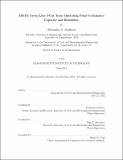| dc.contributor.advisor | Frederick Salvucci and John P. Attanucci. | en_US |
| dc.contributor.author | Malikova, Alexandra A | en_US |
| dc.contributor.other | Massachusetts Institute of Technology. Dept. of Civil and Environmental Engineering. | en_US |
| dc.date.accessioned | 2012-10-26T16:49:20Z | |
| dc.date.available | 2012-10-26T16:49:20Z | |
| dc.date.copyright | 2012 | en_US |
| dc.date.issued | 2012 | en_US |
| dc.identifier.uri | http://hdl.handle.net/1721.1/74271 | |
| dc.description | Thesis (S.M. in Transportation)--Massachusetts Institute of Technology, Dept. of Civil and Environmental Engineering, 2012. | en_US |
| dc.description | This electronic version was submitted by the student author. The certified thesis is available in the Institute Archives and Special Collections. | en_US |
| dc.description | Cataloged from student submitted PDF version of thesis. | en_US |
| dc.description | Includes bibliographical references (p. 147-149). | en_US |
| dc.description.abstract | Transit agencies face a variety of challenges, from increasing ridership to changes in infrastructure, to system expansions, all of which require significant preparation to accommodate the changes without affecting passengers or the agency negatively. The MBTA Green Line, a Boston light rail system serving nearly 230,000 average weekday passengers, will be undergoing major changes in the next two decades, including nearly doubling of ridership and system expansion. In order to prepare for these changes, measures need to be taken to increase capacity and plan for operations on the new segment. Starting in Fall 2010, the MBTA added to a 2-car train operation, and subsequently increased, a number of 3-car trains on three of the four Green Line branches, in order to begin to address the capacity issue. This thesis analyzes service performance before and after implementation of 3-car trains to find that although scheduled capacity increased slightly, the actual capacity of the system remained constant during the morning peak period and decreased during the evening peak period. Furthermore, there were some negative impacts with respect to passenger waiting time and running times, thus worsening the overall passenger experience. However, since 3-car trains will be required for increasing capacity on the Green Line, it is recommended that trials of 3-car trains continue, with the restriction that only 2- or 3-car trains operate on a branch. Furthermore, field observations at terminal stations on two of the branches show differences in operations management practices, which help explain some variability in service along the route, and point to strategies to improve service reliability. | en_US |
| dc.description.statementofresponsibility | by Alexandra A. Malikova. | en_US |
| dc.format.extent | 149 p. | en_US |
| dc.language.iso | eng | en_US |
| dc.publisher | Massachusetts Institute of Technology | en_US |
| dc.rights | M.I.T. theses are protected by
copyright. They may be viewed from this source for any purpose, but
reproduction or distribution in any format is prohibited without written
permission. See provided URL for inquiries about permission. | en_US |
| dc.rights.uri | http://dspace.mit.edu/handle/1721.1/7582 | en_US |
| dc.subject | Civil and Environmental Engineering. | en_US |
| dc.title | MBTA Green Line 3-car train operating plans to enhance capacity and reliability | en_US |
| dc.title.alternative | Massachusetts Bay Transportation Authority Green Line 3-car train operating plans to enhance capacity and reliability | en_US |
| dc.type | Thesis | en_US |
| dc.description.degree | S.M.in Transportation | en_US |
| dc.contributor.department | Massachusetts Institute of Technology. Department of Civil and Environmental Engineering | |
| dc.identifier.oclc | 813791269 | en_US |
